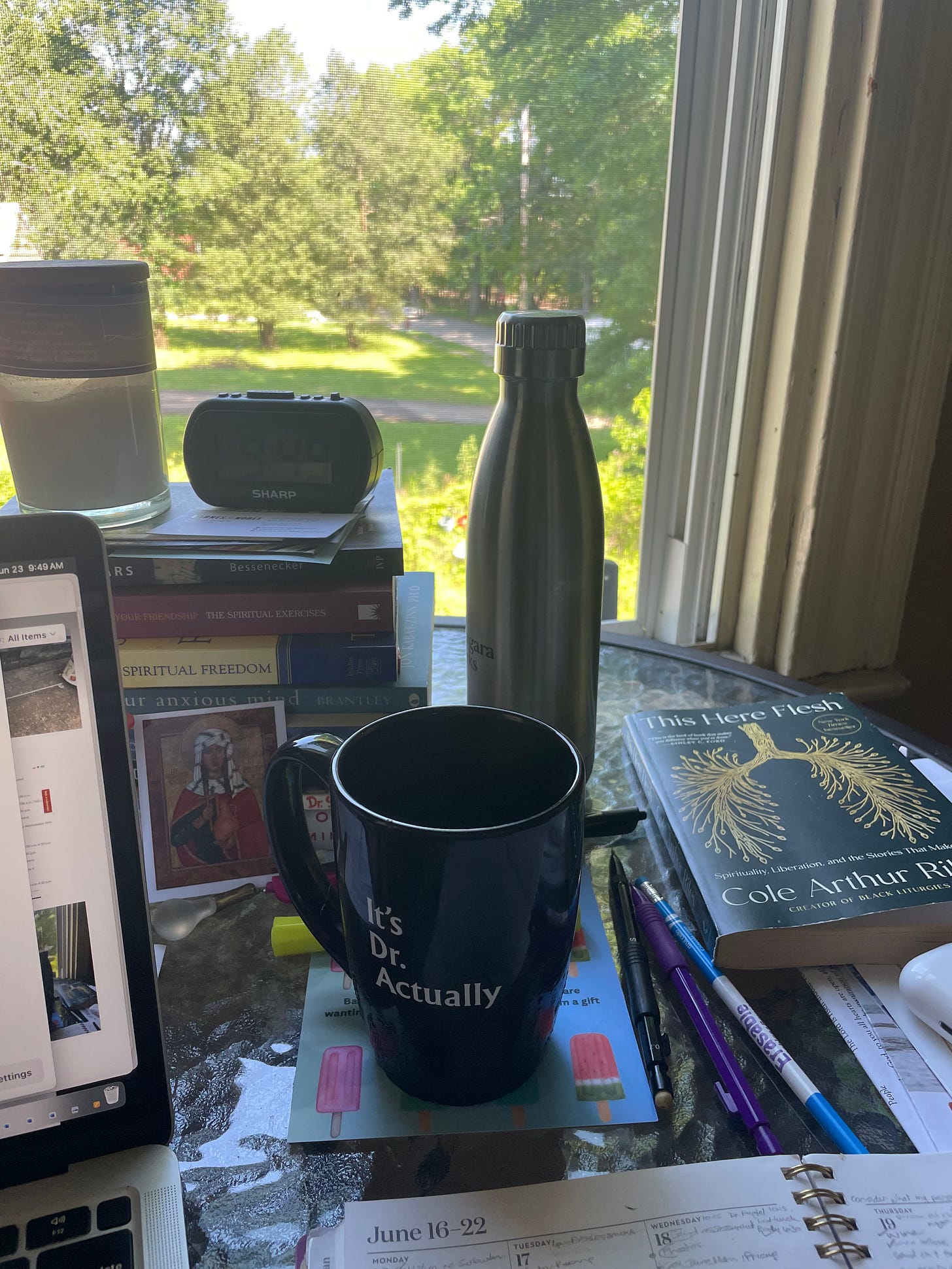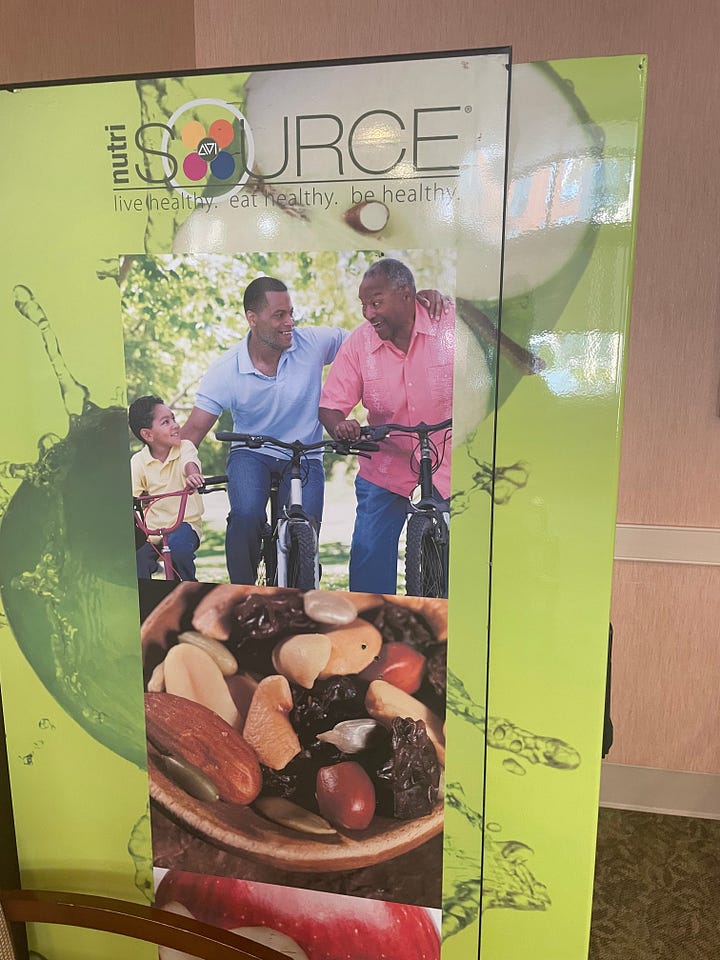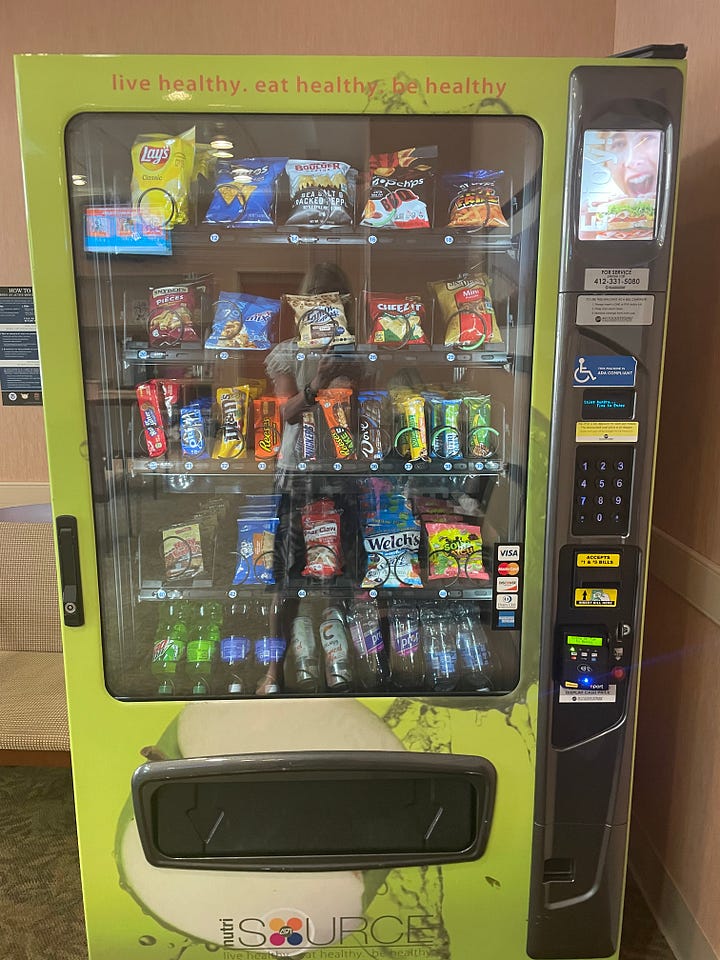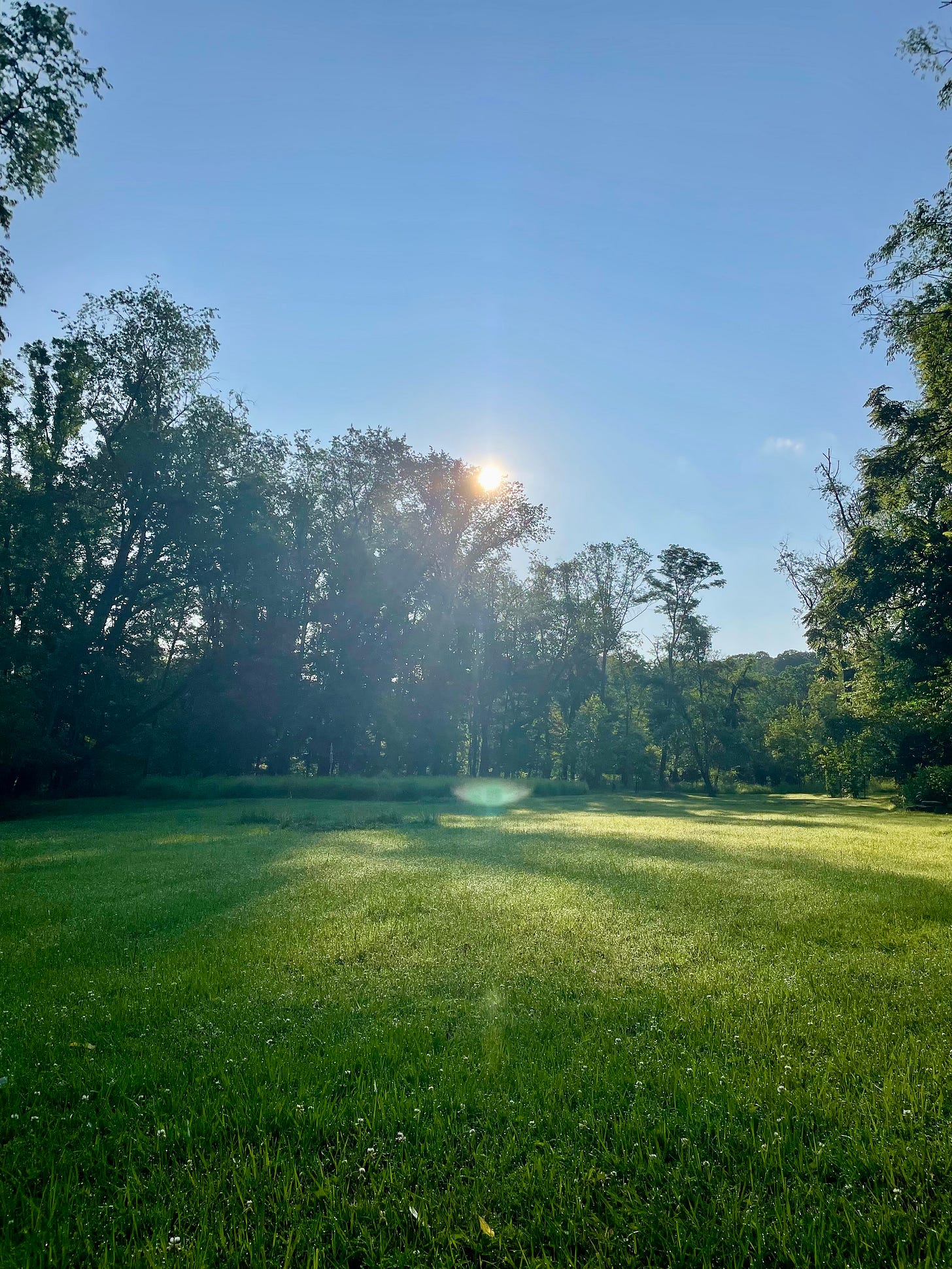June Jam
Staying curious about AI, my tech addiction, an oxymoron, closing in on my final chapter, inflammation
This is Be Well, a space to explore the messy, sacred work of becoming whole. I share stories from my life, the books and ideas shaping me, and honest reflections on what it means to be well in a complicated world.
How I Use AI (and Other Technology)
While I was working on my doctorate—three of the last four years—I was completely paranoid about using AI for anything. I didn’t want to risk plagiarizing or, frankly, getting lazy. So I just didn’t use it. At all.
Fast forward to now: the degree is done, and I’ve written four books—every sentence penned without the help of AI. So, with that behind me, I finally decided to see what all the hype was about. After all, I can’t open a single social media app without being bombarded by sponsored posts selling me the latest “AI for Over-40s” course, promising that it’ll change my life and help me become the person I really want to be.
Hmm.
So, I signed up for a free account with ChatGPT (one of the more popular AI tools out there) and started asking it simple questions—stuff about household chores and DIY projects. No, it didn’t vacuum the house or fold the laundry. But it did give me a nicely prioritized list that helped me actually get started. Interesting.
Over the following weeks, my questions got more specific. I wondered aloud about future course outlines. I asked how I might integrate certain stories into a chapter I was writing. I found myself appreciating a conversation partner who remembers what I’ve said and is available whenever I am. That’s proven surprisingly useful.
Yes, I fact-check. And yes, AI has definitely given me incorrect or even bizarrely wrong information from time to time. But as a content creator (and someone with expertise in a few disciplines), I usually know when something’s off. And I don’t mind calling it out.
Now, I’m not here to evangelize for AI. I just want to be transparent. If you’re a reader of Be Well, I want you to know that it’s me—Joanne—behind the keyboard writing these words, not a robot.
Maybe you're thinking, “Of course,” or “So what?” But I’ve been reading the concerns of those who fear AI will erode trust in our world, and I don’t entirely disagree. The truth is, my trust in the internet was eroded long before AI became mainstream. There’s already so much untrustworthy content online. I’m just as cautious now as I’ve always been, and I approach every source—human or machine—with a healthy dose of skepticism.
Here are a few ways I currently use AI in my work and personal life:
1. Light editing for structure and grammar
2. Generating lists of publishers or agents and how to contact them
3. Planning trip itineraries
5. Searching for new recipes
6. Exploring theological questions and asking for multiple viewpoints with citations
The quality of answers? Ranges from genuinely helpful and thoughtful to laughably wrong. Sometimes it's even fun to catch the mistakes and see how it “responds” when I push back.
As you probably know, I’m a one-woman show. I write, I teach, I speak. I run the tech, sweep the floor, do the invoicing, negotiate contracts, keep my own calendar, write some more, and edit what I’ve written. I’ve had help here and there—a virtual assistant, a publicist, an editor. And I have a very patient and supportive spouse who often pinch-hits behind the scenes. These supports are crucial for bringing my work into the world.
AI, in some small ways, has become another kind of assistant. It’s not personal in the way a human is, but it helps me with some of the mundane busywork that can bog down a creative business. And that gives me more time to do what I most need to do: think.
Much of my creative work—writing books, developing courses—comes from deep thinking. Which, let’s be honest, can sometimes look like I’m just staring off into space. And I love that. I love having the time and mental space to think, to read—a lot. It’s one of the most life-giving parts of my work, and it takes time.

So no, I’m not trying to convince you to use AI. But I do want to share that—at this point in my journey—using AI here and there actually supports my well-being. It allows me to hand off a bit of the busyness so I can focus on the things that truly matter.
I’d love to know—do you use AI? And if so, how? Let me know in the comments section below.
I don’t want to be naive about the tools I use (or refuse to use). I rely on technology to do what I do. And yet, I dream of a time when I can step away from my laptop for a few months. Maybe even—dare I say it—my phone. Sigh.
There was a time, back in my early twenties, when I traveled the world with nothing but a paper map, my backpack and a guidebook. Smartphones didn’t exist (remember those times?) And I still managed to book flights and find my way home to Australia. Imagine that. Now, I feel anxious if I leave the house without my phone. It’s a sobering reminder of how easy it is to become dependent on technology.
I do have boundaries. I use prayer and meditation apps, yes—but I also work hard to keep a healthy relationship with my screens. Even addicts can have standards.
Hi, my name is Joanne, and I’m addicted to 21st-century living. You?
What’s the Opposite of Being Well?
My husband, Doug, had rotator cuff surgery this month. Until the actual day of the procedure, we were both in a bit of denial about what this would really mean for our lives in the weeks (and months) to come. Long-term—say, 9 months or so—he should regain full use and range of motion in his shoulder. That’s the good news.
Short-term? Whole different story.
His arm and shoulder must remain immobilized most of the time. That means: no driving for three weeks, sleeping in a semi-upright position, and needing assistance with daily tasks like dressing, showering, and just getting comfortable. But here we are, fourteen days post-surgery as I write this newsletter, and we’re cruising along. He’s healing well, and we’re adapting to this temporary new normal.
The day of the surgery, I drove Doug to the orthopedic center, armed with my laptop, snacks, and a few other supplies to keep me grounded during the prep, the procedure, and recovery. The waiting area was pleasant enough—comfortable chairs, decent coffee. I settled in for the 3–4 hour wait.
In the corner of the room, I noticed a vending machine. From a distance, it looked… different. It was an inviting light green color, and across the front, in bold, promising font were the words:
“Live Healthy. Eat Healthy. Be Healthy.”
Well, I was intrigued. I walked over to see what sorts of nourishing options might be on offer.
I kid you not—it was a typical vending machine lineup: Snickers, M&M’s, Cheez-Its, potato chips, soda, and a few sad-looking granola bars that could barely pass as food – let alone health food. Nothing even remotely close to anti-inflammatory or nutrient-dense. It was all ultra-processed, sugar-laden, and salt-heavy.


And yet… Live Healthy. Eat Healthy. Be Healthy. Not!
I don’t know why I was surprised. But I was. I suppose I assumed that a small surgical waiting area—attached to a private medical practice—might be more thoughtful in its food offerings. Perhaps something aligned with the very healing process the patients inside were undergoing.
I’m not a physician, and I don’t give medical advice. But I do know what an anti-inflammatory diet looks like—and this vending machine wasn’t it. Not even close.
To me, it was the perfect example of an oxymoron.
“Be healthy,” the machine invited. “Choose wellness.” And then offered nothing of the sort.
So it got me thinking: What is the opposite of being well? Sometimes, it’s not illness or injury. Sometimes, it’s the subtle, unconscious ways we say one thing while doing another—individually, systemically, culturally. We claim to value wellness, but offer little that actually supports it. We long for healing, but we fill the spaces around healing with salt and sugar and slogans.
It’s worth paying attention to. Not just in vending machines—but in all the little ways we’re invited to be well, yet nudged toward something else entirely.
What is an Anti-Inflammatory Diet?
Just in case you are wondering what foods would be on an anti-inflammatory diet; food that really would promote healing (generated with the help of ChatGPT):
1. Protein-Rich Foods
Essential for tissue repair and immune support.
Wild-caught salmon (rich in omega-3s and protein)
Chicken or turkey breast (lean, easy to digest)
Eggs (contain all essential amino acids + choline for healing)
Greek yogurt (protein + probiotics for gut health)
Lentils and beans (plant-based protein + fiber)
Bone broth (collagen, glutamine, and minerals)
2. Anti-Inflammatory Fats
Help reduce swelling and inflammation.
Extra virgin olive oil
Avocados
Nuts and seeds (especially walnuts, flaxseeds, and chia seeds)
Fatty fish (e.g., sardines, mackerel, salmon)
3. Fruits and Vegetables
Rich in antioxidants, vitamins, and fiber.
Berries (blueberries, strawberries, raspberries – high in polyphenols)
Leafy greens (spinach, kale, Swiss chard – high in vitamin K and C)
Sweet potatoes (beta-carotene for skin and tissue repair)
Broccoli and Brussels sprouts (cruciferous and anti-inflammatory)
Bell peppers (vitamin C booster)
Pineapple (contains bromelain, an enzyme that reduces swelling)
4. Whole Grains
Provide energy and help control inflammation.
Quinoa (complete protein + fiber)
Oats (gentle on digestion and good for sustained energy)
Brown rice or wild rice
Barley
5. Fermented Foods
Support gut health and immune function.
Kimchi or sauerkraut
Miso
Kefir
Tempeh
6. Healing Herbs and Spices
Natural anti-inflammatories and immune boosters.
Turmeric (with black pepper to enhance absorption)
Ginger
Garlic
Cinnamon
7. Hydrating and Detoxifying Fluids
Support circulation, digestion, and detoxification.
Plenty of water
Coconut water (electrolytes)
Green tea (antioxidants)
Herbal teas (ginger, chamomile, or peppermint)
Key Nutrients to Focus On:
Vitamin C – for collagen production (found in citrus, kiwi, peppers)
Zinc – immune support and wound healing (pumpkin seeds, beef, chickpeas)
Vitamin A – skin and mucosal healing (sweet potatoes, carrots)
Iron – supports oxygen transport and energy (red meat, lentils, spinach)
B vitamins – for energy and cell repair (whole grains, eggs, legumes)
Here’s what to avoid (Pro Tip: Nearly everything in the vending machine)
1. Processed and Refined Foods
· White bread, white rice, and pastries
· Packaged snacks (e.g., chips, crackers)
· Sugary cereals
These spike blood sugar and offer little nutritional value for healing.
2. Added Sugars
· Soda, energy drinks, sweetened teas
· Candy, desserts, baked goods
· Flavored yogurts and sauces with hidden sugars
Sugar promotes inflammation and suppresses immune function.
3. Fried and Greasy Foods
· Fried chicken, fries, doughnuts
· Fast food burgers and pizzas
These are high in trans fats and refined oils, which slow healing.
4. Highly Processed Meats
· Bacon, sausage, deli meats, hot dogs
Often contain preservatives like nitrates and nitrites, which are pro-inflammatory.
5. Alcohol
· Beer, wine, liquor
Alcohol impairs immune response, dehydrates the body, and interferes with medications and wound healing.
6. Excess Caffeine
· More than 2 cups/day of coffee or energy drinks
Can dehydrate and interfere with sleep, both critical for healing.
7. Artificial Ingredients
· Artificial sweeteners (like aspartame, saccharin)
· Preservatives, food dyes, and flavor enhancers (like MSG)
These may trigger inflammation in sensitive individuals.
8. Dairy (for some people)
· Whole milk, ice cream, heavy cream
May increase mucus production or inflammation in some; opt for plain Greek yogurt or kefir if tolerated.
9. Salty and Packaged Convenience Foods
· Instant noodles, frozen dinners, canned soups
High sodium can lead to water retention and increased blood pressure, which may slow healing.
10. Low-Fiber Foods (in early recovery)
· Especially after abdominal surgery, low-fiber diets may be recommended for a short period. Avoid:
o Raw vegetables
o Whole nuts and seeds
o Popcorn
Follow your provider's guidance on reintroducing fiber gradually.
My Go-to Breathing Practice this Month
Śītalī (Sheetali) Pranayama or Cooling Breath
Benefits
Cools the body and mind
Soothes excess heat (pitta imbalance)
Calms hunger and thirst
Reduces anxiety and agitation
Promotes clarity and a meditative state
When to Use:
In hot climates or post-heated practice
When feeling irritated, overheated, or angry
As part of a calming or cooling yoga sequence
Avoid in cold weather or if you have low blood pressure
Closing in on My Final Chapter
I am so close to finishing that I am now fielding questions on the launch date. However, I am nowhere near launch (controlled by the publisher), but I am one chapter away from completing my final draft. Just in case you think it’s all fun and games (I know you don’t) here’s the chapter outline:
What Does A Good Funeral Look Like?
What is a Funeral? ~ What is Green Burial? ~ What is a Traditional Funeral?
What is a Viewing? ~ What is Cremation? ~ Body and Organ Donation
I am totally absorbed in this chapter, especially green burial. I learned that the only green burial cemetery in the state of Pennsylvania is just 8 miles from my house. It is called Penn Forest.

Ways to Support My Work
Next month I will more fully report and implement ways that you can engage and support my work financially if you wish. If you haven’t filled out the 2 minute reader survey yet, click here to do so.
As always, thank you for reading this far and for taking the time to learn more about what it takes to be well.
Here are the various ways to engage with my work – as in book a one-on-one session with me, book me to lead your retreat, read/buy my books and courses, leave a short review, read previous editions of “Be Well,” etc.:
Read and review my books here.
Book a one-on-one session for yoga therapy or spiritual direction: Email me at joyogi5 at gmail.com. It’s also the best way to contact me for retreat leading availability.
Take my on-demand video course. Click here for more info.
Lastly, if you like this newsletter, would you consider forwarding it to a friend. It also helps people to find this if you click on the little heart below (believe it or not). Comments are always welcome too.
Until next month, keep breathing in the beauty of the summer and staring at the trees.
Be Well!
Joanne
P.S. Thank you for all the birthday love for my 61st back in May! I definitely made up for skipping the big 6-0 last year. This time around included delicious food, joyful connections, thoughtful cards, and even a bit of dancing—every bit a memory-making gift I’m tucking into my heart.
I’ll admit, it feels a little surreal to be officially “over the hill” (or at least what my 40-year-old self assumed was over the hill). But hey—turns out the view from here isn’t bad at all. 😉



